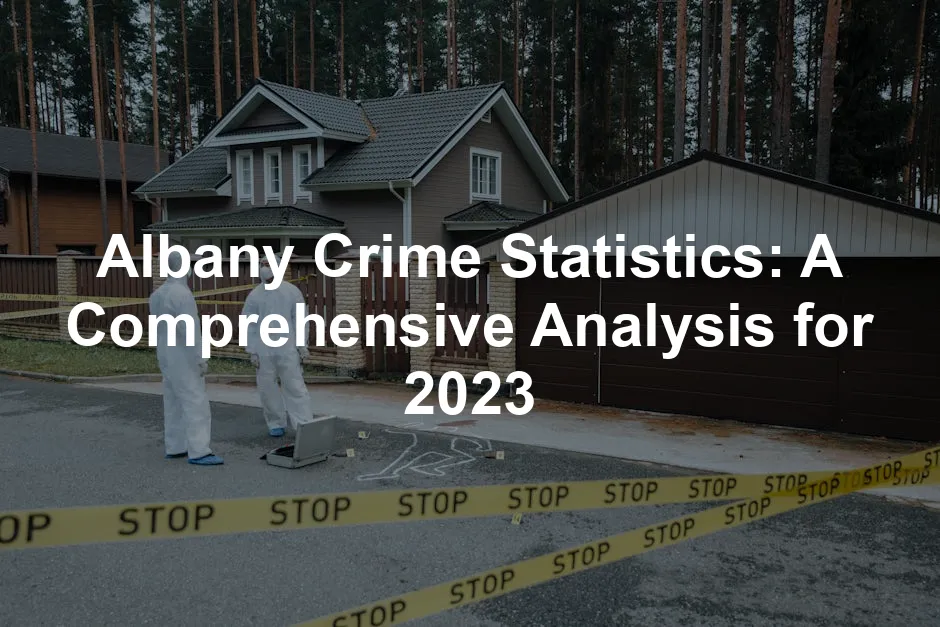Introduction
Albany, the capital of New York, holds a significant place in the state’s history and governance. With its rich cultural heritage, vibrant arts scene, and bustling economy, Albany attracts residents and visitors alike. However, with great charm comes the responsibility of understanding its complexities, particularly concerning safety and crime.
This article aims to provide a thorough analysis of crime statistics in Albany, focusing on recent trends, comparisons, and neighborhood safety. We’ll sift through the numbers to unveil what they mean for current residents and those considering a move to this historic city. Knowing the crime landscape is crucial for anyone living in or contemplating a move to Albany. After all, safety is a priority for families, students, and professionals alike.
Understanding crime statistics can empower residents. It helps them make informed decisions and fosters a sense of community awareness. As we dive into the data, we will explore how Albany’s crime rates stack up against national and state averages, shedding light on areas that may need attention and improvement.
So, whether you’re a long-time resident or a curious newcomer, let’s unravel Albany’s crime story together. And speaking of safety, if you’re looking to enhance your home security, consider investing in a Home Security Camera System. It’s like having an extra set of eyes around your home, ensuring you can keep an eye on things, even when you’re not there.

Crime Rate Overview
Albany has a total crime rate of 46 per 1,000 residents, which might raise eyebrows. To put it simply, you have a 1 in 22 chance of becoming a victim of either violent or property crime here. That’s a number that makes you think twice, doesn’t it?
When we compare Albany’s crime rate with national and state averages, it stands out. More than 99% of communities in New York boast lower crime rates than Albany. This statistic is a wake-up call for many. It highlights the unique challenges this city faces in maintaining safety.
The data is sourced from reliable institutions, including the FBI and local law enforcement agencies. These agencies compile information from over 18,000 law enforcement entities across the country to paint a comprehensive picture of crime in our communities.
Albany’s violent crime rate is recorded at 9.18 per 1,000 residents. While the national median is significantly lower at 4 per 1,000, this disparity emphasizes the need for community engagement and effective law enforcement strategies. Property crime rates are also higher in Albany, sitting at 37.08 per 1,000 residents compared to a national average of 20 per 1,000.
The statistics not only highlight the prevalence of crime in Albany but also serve as a crucial resource for residents and prospective movers. By understanding these figures, individuals can better navigate local neighborhoods, make informed decisions, and contribute to discussions about community safety initiatives. The key takeaway? Awareness is the first step towards a safer Albany.

For a deeper understanding of crime statistics in Albany, you can explore this comprehensive analysis on albany ny crime statistics.
Violent Crime Statistics
Albany has a violent crime rate of 9.18 per 1,000 residents. While that might seem like a number you’d see in a thriller novel, it’s very real and requires attention. To put this into perspective, the national median stands at just 4 per 1,000. So, yes, Albany’s numbers are notably higher, and it’s something that local residents should be aware of.
Let’s break down the types of violent crimes reported in Albany. Grab your notepad because here are the key figures:
- Murder: 11 incidents
- Rape: 68 occurrences
- Robbery: 232 reported cases
- Assault: A staggering 615 incidents
Murder is often the headline-grabber, but it’s essential to look at the broader picture. The 11 murders reported last year may seem low relative to the total population, but every life lost carries a weight that statistics can’t measure.
Next up is rape, with 68 reported instances. This figure emphasizes the importance of community awareness and support for survivors. It’s a serious issue that requires dialogue and action from both law enforcement and the community. If you want to feel more empowered in your personal safety, consider a Personal Safety Alarm. It’s a simple tool that can make a big difference in emergency situations.
Robbery is next on our list. With 232 incidents, this crime type tends to include everything from muggings to more organized thefts. Robberies often leave emotional scars, impacting not only victims but also the community’s overall sense of safety.
Finally, we have assault, which is the most common violent crime in Albany at 615 incidents. This figure paints a somewhat alarming picture, showcasing the need for better preventive measures and community engagement. If you’re serious about self-defense, consider reading a Self-Defense Training Book to equip yourself with valuable skills.
Now, let’s compare Albany’s violent crime statistics to the national averages. The national figures paint a more tranquil picture, with far fewer offenses reported. Albany’s violent crime rate being more than twice the national median suggests a pressing need for strategic interventions.
Understanding these statistics is crucial for residents. It allows them to make informed decisions about their safety and the safety of their loved ones. It’s also a call to action for local authorities and community members to collaborate on solutions.
To wrap it up, Albany’s violent crime statistics reveal a complex and pressing situation. While the numbers can be daunting, they also motivate communities to come together and foster a safer environment for everyone. Let’s be proactive, not reactive, and create a narrative where safety is the central theme of Albany’s story.

Property Crime Statistics
Next, we turn our attention to property crimes in Albany, which have a rate of 37.08 per 1,000 residents. This number is significantly higher than the national average of 20 per 1,000. In simpler terms, that means the chances of being a victim of property crime are about 1 in 27. Ouch!
Now, let’s break it down further. Here’s what the data reveals:
- Burglary: 531 incidents
- Larceny (theft over $50): A whopping 2,651 reported cases
- Motor Vehicle Theft: 557 incidents
Starting with burglary, the 531 incidents indicate that home break-ins are a significant concern. Residents should consider solid security measures—like alarms and good locks—because prevention is always cheaper than dealing with the aftermath. A good Smart Door Lock can be a game changer in securing your home.
Then we have larceny, which encompasses a broad range of thefts. The staggering 2,651 reported cases highlight the fact that petty thefts occur frequently. Whether it’s shoplifting or bicycles disappearing from front yards, larceny seems to be the property crime that plagues Albany the most.
Lastly, motor vehicle theft comes into play with 557 incidents. Cars, bikes, and even scooters are at risk. So, if you love your vehicle, it might be worth investing in a good Bicycle Lock or even a Vehicle Anti-Theft Device to ensure your ride is safe.
When we compare Albany’s property crime statistics to national averages, the city stands out for all the wrong reasons. This elevated rate indicates that residents need to remain vigilant and proactive about their property security.
Understanding these statistics helps residents gauge the safety of their neighborhoods. It also serves as a rallying point for community initiatives aimed at reducing crime.
In conclusion, the property crime situation in Albany offers a mixed bag of challenges and opportunities for improvement. By being aware of these statistics, residents can take steps to protect themselves and their belongings, while also encouraging community efforts to foster a safer environment. Knowledge is power, and in this case, it could mean the difference between being a victim or staying safe and sound.

Neighborhood Crime Analytics
When it comes to understanding crime in Albany, it’s essential to look at the neighborhoods. Not all areas are created equal, and knowing which neighborhoods shine (or struggle) can help residents make informed choices about where to live or visit.
First, let’s spotlight the safest neighborhoods in Albany. If you’re looking for peace and quiet, these areas should be on your radar:
- SUNY at Albany: Home to students and faculty, this neighborhood offers a vibrant atmosphere with relatively low crime rates. Students can focus on their studies without worrying about lurking dangers.
- Buckingham Lake: This area is known for its residential charm and community feel. The locals enjoy a peaceful environment, making it a favorite for families.
- Dunes: A hidden gem, this neighborhood offers a mix of nature and safety. It’s perfect for those who love outdoor activities without the worry of crime.
- Whitehall: With scenic views and a close-knit community, Whitehall boasts lower crime rates, attracting those who appreciate a friendly neighborhood.
- Helderberg: This suburban area is ideal for families, offering both safety and proximity to parks.
- Loudonville East: A well-off area with good schools, it’s a hotspot for families seeking secure living.
- Westmere: Known for its community-oriented atmosphere, Westmere provides a safe haven for its residents.
- Normanskill: A quiet neighborhood with a friendly vibe, Normanskill is another great option for those seeking safety.
- Roessleville East: This area features lower crime rates and a friendly community spirit, making it a desirable location.
- Loudonville: A well-established area with a strong sense of community, it’s not just safe but also inviting.
On the flip side, let’s discuss neighborhoods that have a bit more crime to contend with. Awareness is key here:
- South End: This area has a higher crime rate than others in Albany. Residents should stay vigilant and consider community involvement to improve safety.
- Second Avenue: Known for a mix of residential and commercial activity, this neighborhood experiences more crime than its counterparts.
- West Hill: While it has its charms, West Hill struggles with higher crime rates, making it important for residents to stay informed and proactive.
A graphic representation of crime rates across these neighborhoods could be a game-changer. A map illustrating these areas can help visualize safety hotspots and crime-prone zones. It’s crucial to remember that crime can be unpredictable, but understanding neighborhood dynamics offers valuable insight.
Residents should utilize local resources, such as neighborhood crime watches or community meetings, to engage in conversations about safety. By fostering a community spirit, everyone can contribute to making Albany a safer place for all. Also, consider putting up Neighborhood Watch Signs to deter potential criminals!
In summary, knowing which neighborhoods are safe can help guide decisions for potential residents and current inhabitants. Whether you’re looking for a peaceful retreat or a vibrant community, Albany has options that cater to all preferences.

Local Perceptions of Safety
When it comes to feeling safe in Albany, opinions vary like toppings on a pizza. A recent survey shows that 71% of residents feel “pretty safe.” That’s a comforting thought, right? But wait, there are still 12% who admit they feel “not safe,” and another 12% say it’s a mixed bag of safety concerns. Only 6% of respondents claim they feel “very safe.” So, while most are optimistic, there’s a significant chunk of the population that’s a bit on edge.
What about law enforcement? Well, the police presence is certainly noticeable. According to the same survey, 47% of respondents believe the police are visible but slow to respond when needed. It’s like waiting for your pizza to arrive after a long day— you know it’s coming, but you’d prefer it to be faster. 24% say the police are both visible and responsive, which is a reassuring thought. However, 12% of locals are unsure about police effectiveness, and some feel the police aren’t around much but do respond quickly when called.
These perceptions can shape the community’s overall vibe. If residents feel safe and supported by law enforcement, they’re more likely to engage in community activities and report suspicious behavior. On the flip side, if the sentiment leans toward unease, it can foster a culture of mistrust and withdrawal. To help improve personal safety and peace of mind, consider carrying Pepper Spray. It’s a small but effective tool for self-defense.
In summary, while many Albany residents feel relatively safe, there’s a notable percentage who harbor concerns. The effectiveness and responsiveness of law enforcement play a significant role in shaping these perceptions, emphasizing the need for ongoing dialogue between the community and police.

Comparisons with Other Cities
When we stack Albany against other similar cities in New York, it’s like comparing apples to oranges—if the apples were a bit bruised. Albany’s crime rates are significantly higher than those in cities like Bethlehem and Colonie. For instance, Albany’s violent crime rate stands at 9.18 per 1,000 residents, while Bethlehem manages to keep it around 2.2 per 1,000. That’s quite a leap!
When looking at property crime, Albany again finds itself on the higher end of the spectrum with a rate of 37.08 per 1,000 residents. In contrast, Colonie sits at a much more manageable 15.6 per 1,000. It’s clear that Albany faces unique challenges when it comes to crime.
Albany’s historical context also plays a part. Designed as a hub of governance, it attracts a diverse population, which sometimes leads to higher crime rates. The influx of people can create pressure on resources and law enforcement. This dynamic means that while Albany has a vibrant culture, it also grapples with higher crime statistics than its neighboring cities.
However, every cloud has a silver lining. Albany’s community efforts to address these challenges are commendable. Local initiatives aimed at strengthening neighborhood watch programs and community policing are on the rise. These efforts could help improve perceptions of safety and reduce crime rates over time.
In conclusion, Albany’s crime rates present a mix of challenges and opportunities. While it may not win any awards for being the safest city in New York, ongoing community engagement and proactive law enforcement can pave the way toward a more secure future for its residents. A comprehensive Emergency Survival Kit can also be a wise investment for unexpected situations.

Conclusion
In summary, Albany’s crime statistics reveal a pressing need for community awareness and proactive measures. With a total crime rate of 46 per 1,000 residents, it’s clear that the risk of becoming a victim in this city is alarmingly high, particularly when compared to national averages. The violent crime rate stands at 9.18 per 1,000 residents, which is more than double the national median. This disparity highlights the importance of understanding these figures—not just for current residents, but also for those contemplating a move to Albany.
Being informed about crime statistics is essential for fostering community safety. Knowledge empowers residents to make better decisions regarding their personal safety and the security of their neighborhoods. It’s crucial for individuals to stay updated on local crime trends, as these can fluctuate based on various factors, including economic conditions and law enforcement efforts.
Moreover, understanding crime statistics can encourage community engagement. When residents are aware of issues affecting their neighborhoods, they are more likely to participate in local initiatives aimed at improving safety. Whether it’s attending neighborhood watch meetings or collaborating with law enforcement, community involvement is key to creating a safer environment for everyone.
In addition to awareness, local initiatives play a vital role in enhancing safety. Programs that focus on youth engagement, economic development, and community policing can help reduce crime rates over time. Albany residents should support local efforts and advocate for policies that prioritize safety in their neighborhoods. Investing in a Fire Extinguisher is also a smart move for home safety.
Ultimately, the onus is on the community to work together in making Albany a safer place. By staying informed, engaging with local initiatives, and fostering open dialogue, residents can contribute to a culture of safety and security. So let’s rally together, champion positive change, and create a narrative where safety is the norm, not the exception.

FAQs
What are the safest neighborhoods in Albany?
If you’re looking for safety in Albany, consider these neighborhoods: SUNY at Albany, Buckingham Lake, and Dunes. These areas boast relatively low crime rates, making them ideal for families and individuals seeking peace of mind. Safety can vary significantly from one neighborhood to another, so it’s wise to check local crime reports or community forums for the latest insights.
How can I access more detailed crime data?
For those interested in digging deeper into Albany’s crime statistics, several resources are available. Websites like NeighborhoodScout and City-Data provide comprehensive crime reports that include details on violent and property crime rates. Additionally, local law enforcement agencies often publish annual crime reports that offer insights into trends and community safety initiatives.
What should I do if I become a victim of crime in Albany?
If you find yourself a victim of crime in Albany, the first step is to contact local law enforcement immediately. They can guide you through the reporting process and help ensure your safety. Additionally, consider reaching out to local victim support organizations, which can provide resources and assistance. Remember, you’re not alone, and there are people ready to help.
How does Albany’s crime rate compare to nearby cities?
Compared to nearby cities like Bethlehem and Colonie, Albany faces higher crime rates. For instance, Albany’s violent crime rate of 9.18 per 1,000 residents is notably higher than Bethlehem’s 2.2 per 1,000. This stark contrast underscores the unique challenges Albany encounters in maintaining safety, and highlights the importance of community efforts to improve the situation. By working together, residents can help bridge the gap and foster a safer environment for all.
Please let us know what you think about our content by leaving a comment down below!
Thank you for reading till here 🙂
All images from Pexels




